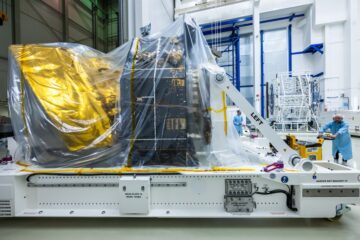This week’s Astronomy & You article covers the relationship between the everyday uses of x-ray and how it originated in astronomy. This piece is by Armagh Observatory and Planetarium’s Michael Burton. He is our Director and before coming to Armagh was the Director of Teaching at the School of Physics in the University of New South Wales in Australia. He is also the President of the International Astronomical Union’s Division B (“Facilities, Technology, Data Science”).
The design of telescopes able to measure the radiation produced by some of the highest energy phenomena in the cosmos has led directly to the development of scanning devices used for security scanning in airports. It has also found application in medical imaging diagnosis through the technique of computer-assisted tomography, or CAT scans.
Building a telescope to focus energetic radiation such as X-rays requires a radically different approach from that used in traditional telescopes. Optical telescopes use lenses or mirrors to focus visible light. X-rays cannot be focused in this way because they have so much energy that they simply pass through the materials used in traditional telescope designs. Instead, use of grazing-incidence mirrors make it possible to focus incoming X-rays from a large collecting area onto a small detector, where they can then be measured.
X-rays also do not penetrate the Earth’s atmosphere. So, the first telescope designed for X-ray astronomy had to be put into space – the Uhuru X-ray telescope.

The discovery of the bright source of X-rays now known as Scorpius X-1 with Uhuru was ground-breaking. Here was an object that emitted a thousand times more X-rays than the Sun, and a thousand times more energy in X-rays than in visible light! Clearly, it was a new class of stellar object in which unknown physical processes were taking place. The X-rays from Scorpius X-1 were then interpreted as the energy released as matter falls down an intense gravitational well from a star onto the surface of a neutron star that it is orbiting.

Equally exciting was the discovery using X-rays that, in what was thought to be empty space within and around clusters of galaxies, there existed a low-density plasma (atoms ionized of their electrons) at temperatures of millions of degrees. Moreover, this extremely hot gas contained more mass than in all the stars in these galaxies. This tenuous material could only be observed in X-rays. Its discovery and subsequent study opened new areas of research into how galaxies have formed. X-ray astronomy has fundamental importance because high-energy phenomena play a crucial role in the dynamics and evolution of the universe.
The development of X-ray and gamma ray telescopes to undertake this research provided the technical tools that have led to important developments with corresponding social consequences. It led directly to the gamma ray imaging technologies used for security scanning at airports for dangerous materials.

The design of telescopes able to measure the radiation produced by some of the highest energy phenomena in the cosmos has found application in medical imaging diagnosis through the technique of computer-assisted tomography or CAT scans. These are used for medical imaging of the body in three dimensions, offering better resolution and greater diagnostic accuracy than traditional X-rays for detecting cancer and other serious medical conditions.




0 Comments